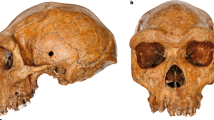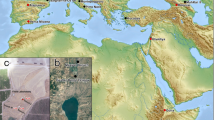Abstract
The origin of anatomically modern Homo sapiens and the fate of Neanderthals have been fundamental questions in human evolutionary studies for over a century1,2,3,4. A key barrier to the resolution of these questions has been the lack of substantial and accurately dated African hominid fossils from between 100,000 and 300,000 years ago5. Here we describe fossilized hominid crania from Herto, Middle Awash, Ethiopia, that fill this gap and provide crucial evidence on the location, timing and contextual circumstances of the emergence of Homo sapiens. Radioisotopically dated to between 160,000 and 154,000 years ago6, these new fossils predate classic Neanderthals and lack their derived features. The Herto hominids are morphologically and chronologically intermediate between archaic African fossils and later anatomically modern Late Pleistocene humans. They therefore represent the probable immediate ancestors of anatomically modern humans. Their anatomy and antiquity constitute strong evidence of modern-human emergence in Africa.
This is a preview of subscription content, access via your institution
Access options
Subscribe to this journal
Receive 51 print issues and online access
$199.00 per year
only $3.90 per issue
Buy this article
- Purchase on SpringerLink
- Instant access to full article PDF
Prices may be subject to local taxes which are calculated during checkout




Similar content being viewed by others
References
Mbua, E. N. Patterns of Middle Pleistocene Hominid Evolution in Africa Dissertation, Univ. Hamburg, (2001)
Stringer, C. B. Modern human origins: progress and prospects. Phil. Trans. R. Soc. Lond. B 357, 563–579 (2002)
Howell, F. C. Paleo-demes, species clades, and extinctions in the Pleistocene hominin record. J. Anthropol. Res. 55, 191–243 (1999)
Stringer, C. B. in The Age of the Earth: From 4004 BC to AD 2002 (eds Lewis, C. L. E. & Knell, S. J.) 265–274, Geological Society of London, Spec. Publ. 190 (2001)
Rightmire, G. P. in Humanity from African Naissance to Coming Millennia (eds Tobias, P. V., Raath, M. A., Moggi-Cecci, J. & Doyle, G. A.) 231–236 (Firenze Univ. Press, 2001)
Clark, J. D. et al. Stratigraphic, chronological and behavioural contexts of Pleistocene Homo sapiens from Middle Awash, Ethiopia. Nature 423, 747–752 (2003)
Howells, W. W. Cranial variation in man. Pap. Peabody Mus. Archaeol. Ethnol. 67, 1–259 (1973)
Tillier, A.-M. in The Evolution and Dispersal of Modern Humans in Asia (eds Akasawa, T., Aoki, K. & Kimura, T.) 15–28 (Hokusen-sha, Tokyo, 1992)
Arsuaga, J. L., Martínez, I., Gracia, A. & Lorenzo, C. The Sima de los Huesos crania (Sierra de Atapuerca Spain): A comparative study. J. Hum. Evol. 33, 219–281 (1997)
Lieberman, D. E., McBratney, B. M. & Krovits, G. The evolution and development of cranial form in Homo sapiens. Proc. Natl Acad. Sci. USA 99, 1134–1139 (2002)
Sarich, V. M. in Conceptual Issues in Modern Human Origins Research (eds Clark, G. A. & Willermet, C. M.) 392–412 (Aldine, New York, 1997)
Bräuer, G. in Humanity from African Naissance to Coming Millennia (eds Tobias, P. V., Raath, M. A., Moggi-Cecci, J. & Doyle, G. A.) 191–197 (Firenze Univ. Press, 2001)
Bräuer, G., (eds Mellars, P. & Stringer, C. B.) 123–154 (Edinburgh Univ. Press, 1989)
Cann, R. Genetic clues to dispersal in human populations: Retracing the past from the present. Science 291, 1742–1748 (2001)
Wolpoff, M. & Caspari, R. in Conceptual Issues in Modern Human Origins Research (eds Clark, G. A. & Willermet, C. M.) 28–44 (Aldine, New York, 1997)
Hawks, J. D. & Wolpoff, M. H. The four faces of Eve: Hypothesis compatibility and human origins. Quat. Int. 75, 41–50 (2001)
Wolpoff, M. H., Hawks, J., Frayer, D. & Hunley, K. Modern human ancestry at the peripheries: A test of the replacement theory. Science 291, 293–297 (2001)
Templeton, A. R. Out of Africa again and again. Nature 416, 45–51 (2002)
Underhill, P. A. et al. The phylogeography of Y chromosome binary haplotypes and the origins of modern human populations. Ann. Hum. Genet. 65, 43–62 (2001)
Ingman, M., Kaessmann, H., Pääbo, S. & Gyllensten, U. Mitochondrial genome variation and the origin of modern humans. Nature 408, 703–713 (2000)
Haile-Selassie, Y. Late Miocene hominids from the Middle Awash, Ethiopia. Nature 412, 178–181 (2001)
White, T. D., Suwa, G. & Asfaw, B. Australopithecus ramidus, a new species of hominid from Aramis, Ethiopia. Nature 371, 306–312 (1994)
Lovejoy, C. O., Meindl, R. S., Ohman, J. C., Heiple, K. G. & White, T. D. The Maka femur and its bearing on the antiquity of human walking: Applying contemporary concepts of morphogenesis to the human fossil record. Am. J. Phys. Anthropol. 119, 97–133 (2002)
White, T. D. et al. New discoveries of Australopithecus at Maka, Ethiopia. Nature 366, 261–265 (1993)
Asfaw, B. et al. Australopithecus garhi: A new species of early hominid from Ethiopia. Science 284, 629–635 (1999)
Asfaw, B. et al. Remains of Homo erectus from Bouri, Middle Awash, Ethiopia. Nature 416, 317–320 (2002)
Howells, W. W. Skull shapes and the map. Craniometric analyses in the dispersion of modern Homo. Pap. Peabody Mus. Archaeol. Ethnol. 79, 1–189 (1989)
Acknowledgements
We thank A. Almquist, A. Asfaw, M. Asnake, T. Assebework, D. Brill, J. D. Clark, J. DeHeinzelin, A. Getty, Y. Haile-Selassie, B. Latimer, C. Pehlevan, K. Schick, S. Simpson, P. Snow and Y. Zeleka for fieldwork and analytical studies; J. L. Arsuaga, A. Gracia and N. Garcia for comparative metric data; C. O. Lovejoy for review; and F. Bibi, D. Brill, R. Cann, Y. Haile-Selassie, L. Hlusko, L. Jellema, R. Klein, J. Matternes and R. Paul for assistance. We thank the Ministry of Youth, Sports and Culture, the Authority for Research and Conservation of the Cultural Heritage, and the National Museum of Ethiopia for permissions; the Afar Regional Government and the Afar people of the Middle Awash, particularly the Bouri–Modaitu community and H. Elema; and many other individuals for contributing to our efforts. This research was supported by the NSF (US) and the Japan Society for the Promotion of Science.
Author information
Authors and Affiliations
Corresponding author
Ethics declarations
Competing interests
The authors declare that they have no competing financial interests.
Supplementary information
Rights and permissions
About this article
Cite this article
White, T., Asfaw, B., DeGusta, D. et al. Pleistocene Homo sapiens from Middle Awash, Ethiopia. Nature 423, 742–747 (2003). https://doi.org/10.1038/nature01669
Received:
Accepted:
Issue Date:
DOI: https://doi.org/10.1038/nature01669




